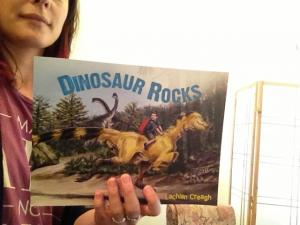Storytime test says Dinosaur Rocks … rocks
Today’s texture Storytime book was Dinosaur Rocks by Lachlan Creagh (published by Lothian) – thoroughly enjoyed by all who attended. But what makes this book a winner?
Set to become an easy favourite
We all know some young fans of dinosaurs, but I’ve struggled to find good dinosaur books that are also good books – good stories, well written and illustrated. This is a terrific one, not least because the dinosaurs in it are Australian.
When Tim goes exploring at Dinosaur Rocks, he meets towering sauropods, soaring pterosaurs, leaping kronosaurs and many more Australian dinosaurs. Some are friendly, but others are dangerous! Will he find his way back home?
– Backcover blurb

One of my favourite books as a child was Sarah Harrison’s In Granny’s Garden, with appropriately lush, jungley illustrations by Mike Wilks. Not only did this book introduce me to a delicious word (diplodocus: still one of my favourites) but, as in Creagh’s Dinosaur Rocks, it celebrates the child’s independent explorations of their world and shows the independent child dealing successfully with challenges and dangers. I loved this aspect then, and still do. Lately, I’ve realised it also taught me something about viewpoint and perspective and how they can be mastered to add depth and emotion to the story in a good picture book.
Spoilers alert! Of course Tim finds his way home! In the care of companionable, motherly, golden-feathered dinosaur Goldie, and with dog Belle along too, Tim is always safe on his adventures, even though they meet several dangerous dinosaurs they need to flee from.

Illustrated by Creagh, as will as written by him, this book integrates text and imagery beautifully, and – as today’s Storytime test showed – is engaging for a young audience and the composition invites readers to explore the layered illustrations. The endpapers, drawn as labelled sketches from Granddad’s dinosaur-spotting journal, were a big hit: we flipped back and forth several times to match up the dinosaurs labelled with the ones in the pictures of the story. That this book invites interaction is no surprise, given Creagh’s background as an illustrator and animator for games.
The typography design is also interesting and engaging, with readers’ attention drawn to key words in the text, which are highlighted with a larger point size and bright colours – orange, yellow, bright blue. Rather than being a gimmicky effect, or a straightforward verb-equals-colour type of rule, the words (or sometimes a whole phrase) picked out are natural to emphasise in the telling of the story and the colour is carefully balanced on the page.
If you’re looking for a great dinosaur book that’s doing things a little differently, this is definitely worth buying for the collection.
Teaching ideas
Activities
The book would naturally lend itself to activities such as:
- matching – flash cards or a list with images (depending on age group) could be used to match dinosaurs on the endpapers to dinosaurs in the book
- classification – ask the children to draw and name their own Australian dinosaurs, with ‘field notes’ (How do we recognise them? Where do they live? What do they eat?)
- writing/composition – write a story about a character who accidentally discovers a special world while out on a walk
- UPDATE - I’ve since found a search-a-word, from Hachette (Lothian’s parent)
Discussion
In Storytime, I like to follow the children’s leads, so today we talked about:
- embossing (young G. noticed the embossing on the inside cover)
- glow worms (the setting includes forests, beaches and caves, as well as Granddad and Nanna’s farm)
- how to make paper from wood (young J. had a theory you made paper from wood…but how?)
Have you read this book? What did you think?